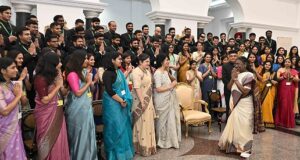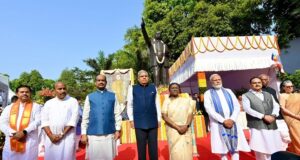Newdelhi:15/4/25:NITI Aayog launched a report on Hand and Power tools sectors – ‘Unlocking $25+ Billion Export Potential – India’s Hand & Power Tools Sector’. The report underscores the transformative potential of hand and power tools industry for India’s economic growth, delving into the challenges, policy headwinds, and necessary interventions vital for strengthening the Indian hand and power tool ecosystem. It outlines a strategic path for the sector to enhance its global competitiveness and capture a significantly larger share of the international market. The report was launched by Shri Suman Bery, Vice Chairman, NITI Aayog in the presence of Dr. V.K. Saraswat, Member, Dr. Arvind Virmani, Member, and Shri BVR Subrahmanyam, CEO, NITI Aayog.
The report suggests that the global trade market for power and hand tools, currently valued at approximately $ 100 billion, is projected to grow significantly, reaching around $ 190 billion by 2035. Within this market, hand tools account for $ 34 billion and are expected to expand to $ 60 billion by 2035, while power tools, including tool accessories, represent $ 63 billion and are anticipated to surge to $ 134 billion, with electrical tools comprising the majority. China dominates global exports, holding about 50% of the hand tools market with $ 13 billion and 40% of the power tools market with $ 22 billion, whereas India has a smaller presence, exporting $ 600 million in hand tools (1.8% market share) and $ 470 million in power tools (0.7% market share).
One important finding of the report is that India has the potential to capture a larger share of the global market, targeting $ 25 billion in exports over the next decade, which could create approximately 35 lakh jobs by achieving a 10% market share in power tools and 25% in hand tools. Through fostering innovation, empowering our MSMEs, strengthening India’s industrial ecosystem, we can solidify the nation’s position as a reliable, high-quality global manufacturing hub. The potential rewards for Indian economy and its people are immense.
The report also analyses the challenges that India may face, including a 14-17% cost disadvantage compared to China, driven by higher structural costs and smaller operational scale. This disadvantage stems from elevated raw material costs, such as steel, plastic, and motors, as well as lower labour productivity due to higher overtime wages and restrictions on overtime hours. Furthermore, higher interest rates and logistics costs for transporting goods from inland states to ports further hinder India’s competitiveness in the global market.
To achieve India’s potential of $ 25 billion in power and hand tool exports over the next decade, the report delves into the issues impacting hand and power tools sectors and recommends three key categories of interventions that are essential. These include:
- Developing world-class hand tool clusters with advanced infrastructure is critical, requiring 3-4 clusters aggregating around 4,000 acres. These clusters operating under a public-private partnership (PPP) model would feature plug-and-play infrastructure, worker housing, and facilities like connectivity and convention centers to streamline operations.
- Addressing structural cost disadvantages through market reforms is necessary, including rationalizing Quality Control Order (QCO) restrictions and import duties on essential raw materials like steel and machinery, simplifying the Export Promotion Capital Goods (EPCG) scheme by easing Authorized Economic Operator (AEO) requirements, and reducing penal provisions like interest on defaults. Additionally, reforms to building regulations and labour laws are needed to enhance competitiveness.
- Providing bridge cost support to offset cost disadvantages is crucial, though no additional support beyond existing schemes like Remission of Duties and Taxes on Exported Products (RoDTEP) and duty drawbacks is required if factor market interventions are effectively implemented. However, the report estimates that in the absence of these reforms, an additional RS. 8,000 crores in bridge support will be necessary, which should be viewed as an investment rather than a subsidy, as it is expected to generate 2-3 times its value in tax revenue over the next five years.
The report observes that the tools industry serves as a foundational pillar of the global manufacturing ecosystem. The Hand and Power Tools sector represent a significant opportunity to realise India’s ambition of becoming a ‘global manufacturing hub’. The report underlines that India stands at the cusp of becoming a developed nation i.e. Viksit Bharat @ 2047, where the industrial eco-system will play a pivotal role. The Hand and Power Tools sector will help enhance our domestic manufacturing and expand our global footprint by $ 25 billion in the next 10 years, with the growth in the construction and DIY markets, augmenting the “Make in India” initiative and accelerating nation’s economic growth.
The report can be accessed at: https://www.niti.gov.in/sites/default/files/2025-04/India_Hand_Power_Tools_Sector_Report.pdf
 Odisha news today, Latest Oriya News Bhubaneswar Online Odia news Portal
Odisha news today, Latest Oriya News Bhubaneswar Online Odia news Portal




